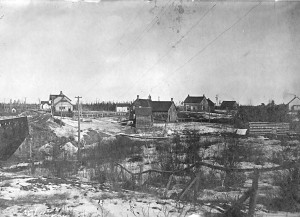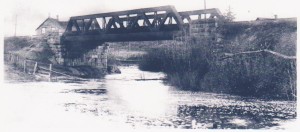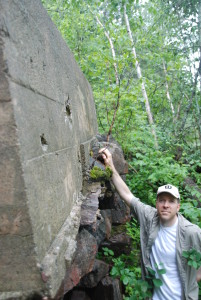Oldest Structure In Northern Ontario – Callander/North Bay
Not the Pyramids – Old Just the Same and Our Heritage
Not Preserved or Recognized
by Back Roads Bill
For thousands of years pyramids have been built by civilizations in many parts of the world. Khufu’s Pyramid (2530 B.C.) is built mainly of limestone and granite blocks and is considered an architectural masterpiece, one of the ‘Seven Wonders of the Ancient World.’ These are the remains of a vanished culture. Think about this and the following.
Northern Ontario has less than 150 years of continuous, colonial, settlement history. We are hard pressed to identify what is the oldest engineered, humankind piece of work that survives from our meager beginnings. North Bay came into being in 1881 because of the Canadian Pacific Railway (CPR), it was the catalyst.
‘Community Voices’ wondered what the oldest, remaining engineered work in the area was. Never mind North Bay, what we re-discovered, most likely, is one of the oldest remains of “what was” in all of Northern Ontario.
In the early 1880’s the CPR ruled the landscape through the ‘National Dream” of railway development. Downtown wooden buildings were quickly erected on Main St. The brick buildings came a little later and so did the Victorian homes of Main and McIntyre Streets (west). What remains from the 1880’s era today – a significant railway abutment further south at Nipissing Junction.
Chasing the transcontinental CPR was a Toronto-North Bay railway company called the Northern and Pacific Junction Railway (N&PJR). Shortly after the line was built, the company was bought out by the Grand Trunk Railway in 1888.
What Remains and Why?
Deryk Hagar is a staff member of the Callander Bay Heritage Museum and is a heritage consultant. He knows his stuff. He thinks Nipissing Junction is a site of national significance.
In 2010 Mr. Hagar, through his own volition, authored the ‘Nipissing Junction: Potential for Designation as a National Historic Site’ study. He tried to interest and involve local organizations (Heritage North Bay), including the City of North Bay (municipal heritage committee and Councillor Chris Mayne and Mayor Vic Fedeli), and the Friends of La Vase Portages group, to have the site recognized for its local, provincial and national significance.
“Toronto was going about securing a charter to extend their network from southern Ontario to reach the new transcontinental CPR – providing Toronto with direct access, since it wasn’t anywhere near the surveyed CPR route. Toronto desperately wanted to compete with the increased trade and traffic going to Montreal from the West,” said Mr. Hagar.
“The press called it ‘The Callander Extension’ at that time. Nipissing Junction became the “joining” point in January, 1886. I believe they chose the La Vase portage area / CPR depot as the Junction site because of its ease of access, and the fact that the CPR was already active in building their own line here.” Of great significance, “The first clearances along the already surveyed right of way for the CPR ‘Eastern Section’ began in April-May of 1881 along the La Vase River. Work crews used the third portage of the La Vase Portages. The Globe newspaper in Toronto sent a correspondent up to report on the progress.” (This portage was closest [west] to Lake Nipissing. The south portage head was where the Kate Pace Way abuts the golf driving range on Lakeshore Drive and runs to where the abutment is located.)
Within the newspaper report of April 27, 1885 describing the La Vase bridge, “Coming down south of the junction with the CPR…over this is a Howe truss span, 80 feet wide, built on rock foundation with solid granite abutments…” Overgrown but very discernible as a bridge abutment, you will see the solid granite blocks and the dry-laid (no mortar) retaining wall of rocks, that all form fit. The dry laid portion is amazing as it is true masonry. These rocks were quarried (steam driven hand drill – the holes are visible) and then with wedges split by hand to create, flat, straight, angular blocks. It was labour intensive, traditional stone masonry. The face stones on the abutment were “dressed and coursed,” giving a quality finish to the work. This supported the steel spans and the locomotives/trains.
Years later the abutment was fortified and enlarged with concrete; you can see wood grain of the wood forms (board-cast) within the wall. The original granite/gneiss masonry remains underneath, still visible on the north side. There is also an original “80 pound rail” on one side of the abutment, stuck into the ground. It is a shame, but much of the rail bed fill has been hauled away by the public for a variety of landscaping and home renovations (I suppose it is the “Reuse” principle at work).
What then happened to all of this? The Grand Trunk Railway over extended itself with the Grand Trunk Pacific / National Transcontinental scheme in the 1910’s; and with WWI, it eventually bordered on bankruptcy and was nationalized into Canadian National Railways between 1919 – 1923. The junction point was abandoned at that time, and the line was rerouted immediately north of the concrete bridge at Decaire Road (behind the Tim Horton’s gas station/truck repair business). It was diverted north-east here to join with the former Canadian Northern right of way, also nationalized into CNR in 1923. Of note, the track through Callander was removed completely in 1973, and since that time CNR trains used their lines located on the east side of Hwy 11.
Today, the north abutment of the old La Vase bridge is on city property. The south abutment and remaining rail bed was on Ministry of Transportation property, but an erroneous Land Registry entry caused the title to fall into private hands and was not corrected by the government.
Have a Look
The Nipissing Junction abutment is found on Junction St. (Nipissing Junction Gospel Hall on Lakeshore Drive.) Turn north on to Junction St., Junction becomes Ritchie St. and park at the Toronto/Ritchie St. sign, beside the La Vase River. To the south (right), 30 m off of the street, you will see the remains of the original N&PJ / Grand Trunk Railway bridge abutment at the narrowest point of the river. See WGS 84, ZONE 17 T E 623463 N 5124887 or N46° 15.980’ W79° 23.868’. The railway station would have been approximately 100 m north following Junction St. to its end. This area is also the location for the upper end of the third, historic La Vase portages.
Other early remaining railway evidence in the area is the restored station in South River, partially a N&PJR station. Near Nipissing Junction is another bridge with a 1914 date stamp, (Decaire Rd. and Pinewood Park Drive). There is an original sandstone block abutment on the railway trestle in Powassan crossing Genesee Creek, and part of the CPR railway trestle spanning Duchesney Creek, (Nipissing First Nation/City of North Bay boundary; look at the granite blocks). There is the original roadbed of the Nipissing and James Bay Railway along the Canadore hiking trails, another proposed railway project, but never completed. The Temiskaming and Northern Ontario (ONR) was built instead, a decade later.
The ancient pyramids are among the most astonishing structures in the world. The remains of this block railway bridge abutment is an era of significance. It is a “time of ours, worthy of our praise and preservation”; will we have the will to help Deryk Hagar?



